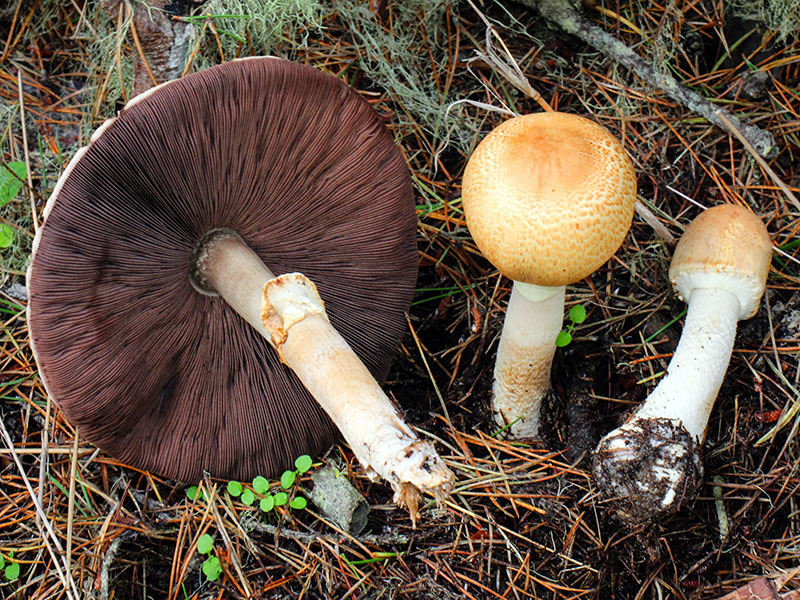Agaricus smithianus
Index Fungorum 526: 1. 2022.
Common Name: none
Synonym: Agaricus smithii Kerrigan
Misapplied name: Agaricus perrarus
-
Pileus
Cap 7.0-12.0 cm broad, cylindical-convex, expanding to broadly convex, finally plane; margin decurved, sometimes slightly fringed with veil fragments; surface in youth appressed-fibrillose to finely squamulose, the fibrils pale-yellowish over a whitish ground color, becoming fibrillose-squamulose, the scales hazel-brown, tawny-brown where handled; context white, up to 1.5 cm thick, unchanging; odor and taste almond-like.
-
Lamellae
Gills free, close to crowded, relatively broad, at first pallid, then pinkish-buff, at maturity chocolate-brown; edges lighter than the faces; lamellulae in four to five series.
-
Stipe
Stipe 5-12 cm tall, 2.0-3.0 cm thick, with a cottony central core, equal except for a bulbous base; surface of apex more or less glabrous, lower portion with appressed, scattered, white to yellowish-tawny fibrils; veil two layered, consisting of buff, cottony-floccose patches arranged in a cog-wheel pattern over a white, fibrillose under-layer; annulus superior, pendant.
-
Spores
Spores 7.0-9.0 x 5.0-5.5 µm, oblong-elliptical in face-view, slightly inequilateral in profile, i.e. with a curved and flat side, smooth, moderately thick-walled, hilar appendage conspicuous; spores dark chocolate-brown in deposit.
-
Habitat
Solitary or in groups in mixed hardwood-conifer woods, often associated with Picea sitchensis (Sitka Spruce); found from Sonoma County northward along the coast; fruiting shortly after the fall rains; occasional to locally common.
-
Edibility
 Edible and good.
Edible and good. -
Comments
Like other members of the "Arvensis group," Agaricus smithianus has an almond-like odor and bruises slowly, persistently yellow. Agaricus augustus, the Prince, is a close cousin distinguished by larger size, darker brown cap scales, and lack of a bulbous stipe base. The two species also have different fruiting seasons, Agaricus smithianus from late fall to early winter, Agaricus augustus, spring, summer and early fall. It would also be possible to confuse Agaricus smithianus with Agaricus perobscurus. This faintly anise-odored species fruits during the winter months, but it has a darker brownish cap and lacks the bulbous stipe base. Lastly, Agaricus smithianus should be compared with Agaricus silvicola. While similar when young, at maturity Agaricus smithianus develops yellowish-brown to tawny, flattened cap scales, the cap of Agaricus silvicola normally remaining appressed-fibrillose. Additionally, the spores of Agaricus smithianus are almost two microns longer than Agaricus silvicola.
-
References
Kerrigan, R.W. (1985). Studies in Agaricus III. New species from California. Mycotaxon 12: 419-434. (Protologue for A. smithianus)
Kerrigan, R.W. (1986). The Agaricales (Gilled Fungi) of California. 6. Agaricaceae. Mad River Press: Eureka, CA. 62 p.
Kerrigan, R.W. (2016). Agaricus of North America. New York Botanical Garden: Bronx, NY. 574 p.
Kerrigan, R.W. & Parra, L.A. (2022). Nomenclatural novelties. Index Fungorum 526: 1.
Siegel, N. & Schwarz, C. (2016). Mushrooms of the Redwood Coast. Ten Speed Press: Berkeley, CA. 601 p. -
Other Descriptions and Photos
- Alan Rockefeller: Agaricus smithianus (CP)

- Darvin DeShazer: Agaricus smithianus (CP)

- Don Bryant: Agaricus smithianus (CP)

- Don Bryant: Agaricus smithianus (CP)

- Don Bryant: Agaricus smithianus (CP)
- MushroomExpert.com: Agaricus smithii (D & CP)
- Alpental: Agaricus smithii (CP)
- Alan Rockefeller: Agaricus smithianus (CP)
